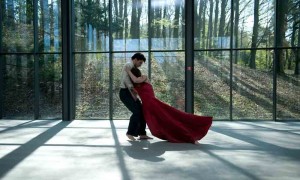New film explores movement via dance
Wim Wenders new 3-D dance documentary, Pina, is Germany’s official entry for the Academy Awards and, more importantly, a stunningly gorgeous film.
It is a strange sensation to watch a documentary in 3-D, though Pina isn’t the first of its kind. For this movie’s purpose, however, the format works incredibly well.

Dancing queen · Pina, the German documentary commemorating the dancing and choreography of the legendary Pina Bausch, comes to life with its vivid imagery and captivating cinematography. The film is further enhanced by the lively 3-D screen, serving as a beautiful tribute to the legend herself. - Photo courtesy of IFC Films
The film is largely composed of numerous dance pieces choreographed by the film’s namesake, Pina Bausch, and uses technology beautifully to play up the depth of the stage and the spaces between the dancers — every movement of the dancers’ bodies is accentuated due to the subtle effect of the 3-D.
There is very little in the way of contextualizing any of the dances; Wenders gives the viewer almost no information about the history of the routines, the company or Bausch herself.
The film is much more a showcase of Bausch’s work than it is a portrait of her as a human being. Wenders never delves into Pina’s background, her life or her untimely death from cancer a mere five days after diagnosis and two days before the film was set to begin production.
Instead, the film largely cuts between striking footage of the dances she choreographed and interviews with the dancers in her company.
The most fascinating thing about these interviews, though, is that one never actually sees anyone speaking. Each of the dancers highlighted in the film merely sits in front of the camera pensively, making various facial expressions while the actual audio recordings of their interviews are used as a voiceover.
It’s an interesting take on the interview format, allowing the viewer to focus on the physical emotions of the people they’re viewing through the tiniest movements on their faces. This format is a testament to the fact that dancers make their livings with their bodies through the singular use of movement, thus showcasing Wenders’ clever directing skills.
Wenders also lets each of his interviewees speak in their native tongue, with subtitles in English displayed on the screen, thus highlighting the multicultural integration of the dance company as well as the idea that dance and Bausch’s expressive themes are universal.
Many of the routines in the film are set in outdoor locations: next to a busy street, in monorails, parks, railroad tunnels and abandoned buildings. These locations create a unique context for the dances and are much of the reason why the film is so beautiful.
These settings are Wenders’ main contribution to the dances and he creates several gorgeous compositions with various environments throughout Pina. The film incorporates natural elements into several of Bausch’s dances, even flooding the stage with water for one of the more spectacular pieces. The colors, in particular, are beautifully vivid: the blue sky, the blood-red dancer outfits and the surrounding greenery all contribute to a sense of wonder.
Wenders also employs several unique film techniques to show the dances in a way they could never be seen on stage. He cuts between the stage and other locations while the same dance takes place. Additionally, there is one routine in which he cuts between dancers of different ages doing the same movements in the same costumes, expertly portraying the passage of time and how the various levels of sensuality within the choreography are perceived at various stages of life.
Through the presentation of her choreography in the film, it becomes clear that Bausch was deeply interested in sex, nature, the elements, repetition, urgency, sorrow, fear, passion and the dynamic between men and women.
For instance, the film opens with the preparation for “The Rite of Spring,” with several dancers covering the floor of a stage that features a giant dirt square on which they perform. It’s an extremely simple and primal setting for a dance that largely communicates terror, lust and power — a dance in which each dancer naturally gets filthier and filthier as the performance progresses.
The film ends with a quote from Bausch herself: “Dance, dance, otherwise, we are lost.” These words seem to explain Bausch’s lifelong relationship with dance as something she was incapable of living without.
Wenders is clearly full of the same passion for both dance and film. Here, his collaboration with Bausch offers beautiful imagery through the combination of two mediums supremely and uniquely human, both deeply rooted in movement and emotion.
